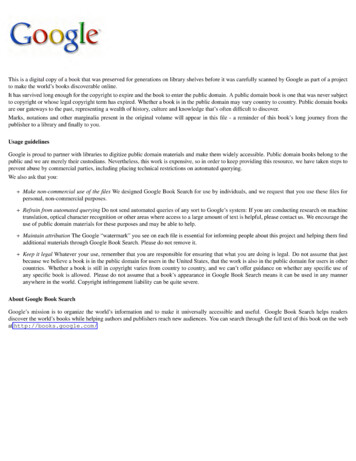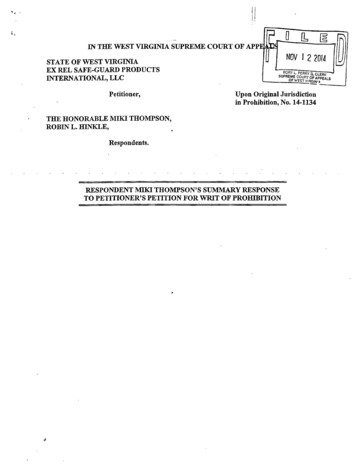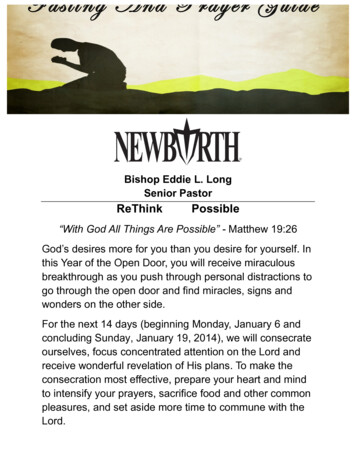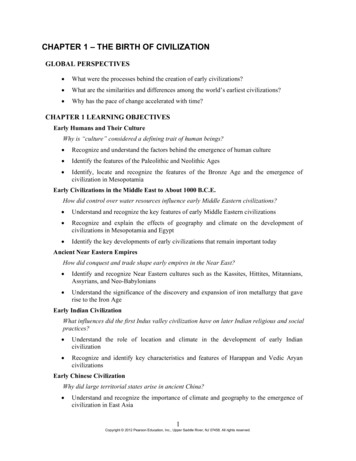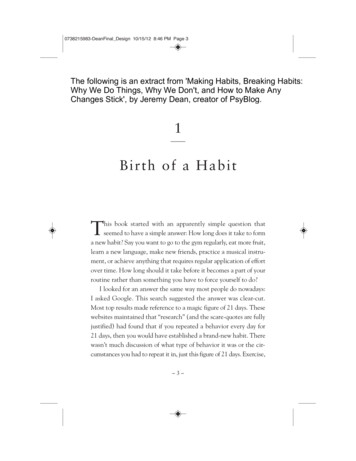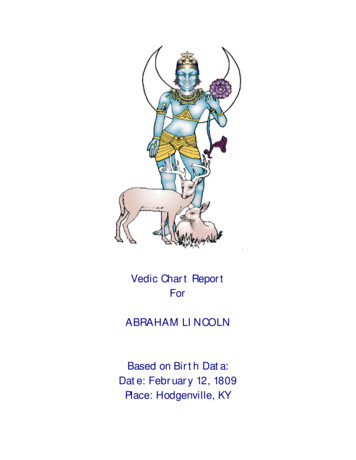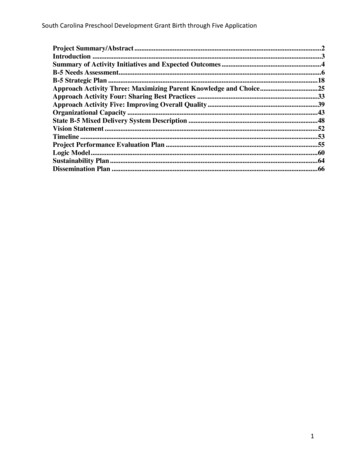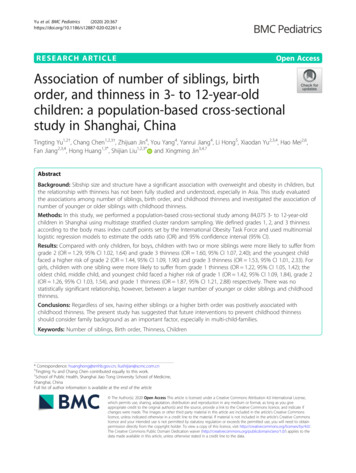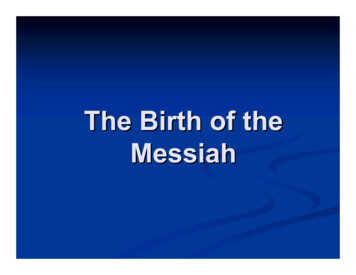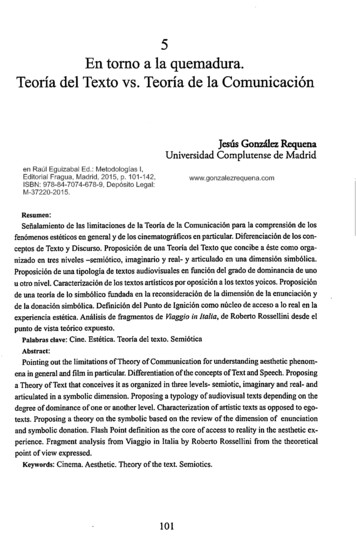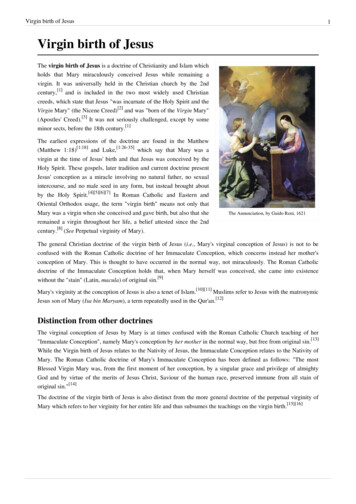
Transcription
Virgin birth of Jesus1Virgin birth of JesusThe virgin birth of Jesus is a doctrine of Christianity and Islam whichholds that Mary miraculously conceived Jesus while remaining avirgin. It was universally held in the Christian church by the 2ndcentury,[1] and is included in the two most widely used Christiancreeds, which state that Jesus "was incarnate of the Holy Spirit and theVirgin Mary" (the Nicene Creed)[2] and was "born of the Virgin Mary"(Apostles' Creed).[3] It was not seriously challenged, except by someminor sects, before the 18th century.[1]The earliest expressions of the doctrine are found in the Matthew(Matthew 1:18)[1:18] and Luke,[1:26-35] which say that Mary was avirgin at the time of Jesus' birth and that Jesus was conceived by theHoly Spirit. These gospels, later tradition and current doctrine presentJesus' conception as a miracle involving no natural father, no sexualintercourse, and no male seed in any form, but instead brought aboutby the Holy Spirit.[4][5][6][7] In Roman Catholic and Eastern andOriental Orthodox usage, the term "virgin birth" means not only thatMary was a virgin when she conceived and gave birth, but also that sheremained a virgin throughout her life, a belief attested since the 2ndcentury.[8] (See Perpetual virginity of Mary).The Annunciation, by Guido Reni, 1621The general Christian doctrine of the virgin birth of Jesus (i.e., Mary's virginal conception of Jesus) is not to beconfused with the Roman Catholic doctrine of her Immaculate Conception, which concerns instead her mother'sconception of Mary. This is thought to have occurred in the normal way, not miraculously. The Roman Catholicdoctrine of the Immaculate Conception holds that, when Mary herself was conceived, she came into existencewithout the "stain" (Latin, macula) of original sin.[9]Mary's virginity at the conception of Jesus is also a tenet of Islam.[10][11] Muslims refer to Jesus with the matronymicJesus son of Mary (Isa bin Maryam), a term repeatedly used in the Qur'an.[12]Distinction from other doctrinesThe virginal conception of Jesus by Mary is at times confused with the Roman Catholic Church teaching of her"Immaculate Conception", namely Mary's conception by her mother in the normal way, but free from original sin.[13]While the Virgin birth of Jesus relates to the Nativity of Jesus, the Immaculate Conception relates to the Nativity ofMary. The Roman Catholic doctrine of Mary's Immaculate Conception has been defined as follows: "The mostBlessed Virgin Mary was, from the first moment of her conception, by a singular grace and privilege of almightyGod and by virtue of the merits of Jesus Christ, Saviour of the human race, preserved immune from all stain oforiginal sin."[14]The doctrine of the virgin birth of Jesus is also distinct from the more general doctrine of the perpetual virginity ofMary which refers to her virginity for her entire life and thus subsumes the teachings on the virgin birth.[15][16]
Virgin birth of Jesus2New TestamentKey articles onMariologyGeneral perspectiveMother of JesusSpecific viewsAnglican Eastern Orthodox Lutheran Marian veneration Muslim Protestant Roman CatholicPrayers & devotionsHymns to Mary Hail Mary RosaryEcumenicalEcumenical viewsThe earliest Christian preaching about Jesus concerned his death and resurrection, and the early Church turned itsattention to the chronology of the rest of the life of Jesus later.[17][18][19] Early Christians were hardly monolithic intheir preachings, and the Nativity accounts of the gospels may have diverged as a result, but a comparison of theNativity stories of Luke and Matthew show common elements in terms of the virgin births, the birth at Bethlehemand the upbringing at Nazareth.[18][20]GospelsThe accounts of the birth and Nativity of Jesus appear in only two of the four Canonical Gospels, the Gospel of Lukeand the Gospel of Matthew. Luke's story centers on Mary, while Matthew's story centers on Joseph, and in bothgospel accounts (Luke 2:1-7 and Matthew 2:1) Jesus is conceived without a human father.[21][22][23]Neither Luke nor Matthew claim that their birth narratives are based on the direct testimonies of either Mary orJoseph.[24] James Hastings and separately Thomas Neufeld have expressed the view that the circumstances of thebirth of Jesus were deliberately kept restricted to a small group of early Christians, and were kept as a secret formany years after his death.[25][26] Ronald Brownrigg suggests that the narrative in Luke was obtained via a path fromMary, while the narrative in Matthew was obtained from a path on Joseph's side.[27]MatthewThe Gospel of Matthew (c 80-85) begins with a genealogy leading from Abraham to Joseph, but then calls Joseph"the husband of Mary, of whom (Mary) was born Jesus, who is called Christ."[1:16] The original Greek text, whichhas "ἐξ ἧς" (feminine singular), shows that the phrase "of whom" refers to Mary, not to Joseph or to Mary andJoseph together.[1:16] It then states that, when Mary was found to be pregnant, she had not lived with Joseph, towhom she was engaged,[1:18] and that he did not have marital relations with her before the child was born.[1:25]Matthew then states: "That which is conceived in her is of the Holy Spirit",[1:20] in fulfillment of the prophecy of theprophet: "A virgin shall be with child, and shall bring forth a son, and they shall call his name Emmanuel, whichbeing interpreted is, God with us."[Mt. 1:22-23] Scholars interpret "prophet" as a reference to Isaiah 7:14.[28] Some 5thand 6th century manuscripts read "Isaiah the prophet".[29]
Virgin birth of JesusHebrew has a specific word "almah", which may mean "maiden," "young woman," or "virgin". When Matthew 1:22states: "Behold the virgin shall be with child" it uses the Greek term "parthenos" as "virgin" as in the Septuaginttranslation of Isaiah, while the original Masoretic Isaiah uses the Hebrew "almah".[30] This Greek translation "altersor refines the meaning of Isaiah's original Hebrew: where the prophet had talked only of a ‘young woman’conceiving and bearing a son, the Septuagint projected ‘young woman’ into the Greek word for ‘virgin’(parthenos)."[31] Raymond Brown suggests that the translators of the Septuagint may have understood the Hebrewword "almah" to mean virgin in this context.[30]LukeThe Nativity is a prominent element of the Gospel of Luke (c 85-90), and comprises over 10% of the text, beingthree times the length of the Nativity text in the Gospel of Matthew.[32] In Luke 1:30-35 Mary asks how she is toconceive and bear a son, since she is a virgin; and she is told it will happen by the power of God. Luke 3:23-38 givesa genealogy, different from that given by Matthew. Scholars differ on which of the two, Matthew or Luke, is thelegal genealogy via Joseph, and which the physical descent via Mary.[33]When the angel Gabriel tells Mary that she will bear a son conceived by the Holy Spirit,[Lk. 1:26-38] she responds withthe Magnificat,[Lk. 1:46-55] a prayer of joy.[34]Pauline epistlesThe Pauline epistles, the earliest surviving Christian writings, refer to Jesus' mother without stating that she was avirgin. Instead Paul focuses on contrasting the birth of Jesus with the fall of Adam, and presents Jesus as the"firstborn of all creation", and a second Adam, in Colossians 1:15-16.[7][35][36][37] Some[38] see the silence of Paul onvirginity as implying that he knew of no account of the virgin birth of Jesus, while scholars such as Raymond Brownreject the "argument from silence" and state that Paul's letters were composed with a view to ecclesiastical problemswith which he had to deal, not to give a narrative of the life of Jesus.Raymond E. Brown states that given the multiple lines of reasoning, there are no convincing arguments to determinewhether Paul knew of the virgin birth or not.[39] Brown writes that it is difficult to decide whether Paul's silence onthe question of the virginal conception of Jesus is significant in any case.[39] Brown states that, even if the silence ofPaul is taken to indicate ignorance of the virgin birth, it does not disprove it, for a family tradition about it couldhave circulated among relatively few in the years 30-60, before becoming known to the communities for whomMatthew and Luke wrote.[40] Other authors have noted that the silence of Paul is no indication, given the PaulineEpistles were not intended as chronologies and include very few details of the life of Jesus in general, and that eventhe Last Supper was only mentioned by Paul in response to problems in Corinth.[41]Specific passages in Paul's letters include Galatians 4:4, usually translated as: "when the fullness of time had come,God sent his Son, born of a woman, born under the law". (The word translated as "born" literally means "havingcome to be",[42] and Young's Literal Translation gives the phrase as "come of a woman, come under law".) Some seethis silence about a virgin birth as lack of knowledge of it, while others see the phrase "born of a woman, born underthe law" as implying that Jesus had no human father.[43][44] The opening of the Epistle to the Romans(Romans 1:1-4) includes the words: "concerning his Son, who was descended from David (or who came from theoffspring of David) according to the flesh and was declared to be the Son of God in power according to the Spirit ofholiness by his resurrection from the dead, Jesus Christ our Lord". Some take "descended from David according tothe flesh" to mean that Joseph, a descendant of David, was the physical father of Jesus, thus denying the virgin birthof Jesus, others take it as indicating that Mary too was a descendant of David.[45][46][47][48] Others point out thathere, as in Galatians 4:4, Paul does not use the ordinary word for "born" (γεννητός, gennetos, the word used inMatthew 11:11 in relation to John the Baptist being "born of a woman"), but the word γενόμενος, genomenos,literally meaning "become", "come to be",[49][50] a fact that some interpret as an allusion to incarnation of thepre-existent Son of God.[51][52]3
Virgin birth of Jesus4The statement in Romans 8:3-4 that God sent his Son "in the likeness of sinful flesh" has been interpreted asmeaning merely that Jesus was externally just like any other human being, supported by Paul's remark elsewhere thatChrist "knew no sin".[2 Cor 5:21] Others suggest a contradiction between Paul's notion of being "in the likeness ofsinful flesh" and his having been born of a virgin. In 1Timothy 1:4, where Paul urges people not to "occupythemselves with myths and endless genealogies which promote speculations.", has been debated as to whether itindicates that Paul had a negative view of the developing virgin birth stories and their variant genealogies.[53]Old TestamentIsaiahTherefore the Lord himself shall give you a sign; Behold, analmah shall conceive, and bear a son, and shall call his nameImmanuel. Butter and honey shall he eat, that he may know torefuse the evil, and choose the good. For before the child shallknow to refuse the evil, and choose the good, the land that thouabhorrest shall be forsaken of both her kings.[54]In this passage from the book of Isaiah the prophet predicts to kingAhaz that a young woman will give birth to a child who will be called"Immanuel", meaning "God with us", and that Ahaz's enemies will bedestroyed before this child learns the difference between good and evil,i.e., before it reaches maturity. The Hebrew word is " ( "עלמה almah),which scholars agree means a young woman of child-bearing age,without any connotation of virginity, and the context of the passagemakes it clear that Isaiah has in mind events in his and Ahaz's nearfuture. The Greek-speaking author of Matthew, however, used theGreek translation of Isaiah, in which the word is given as "παρθένος",parthenos, meaning a virgin.[55]Isaiah by Michelangelo, Sistine ChapelThe Qur'anAlthough not specifically mentioned in the Quran, Muslims believe that Jesusand Mary were the only two children not to be touched by Satan at themoment of their birth, for God placed a veil between them and Satan.[56]The Qur'an says that Jesus was the result of a virgin birth. The most detailedaccount of the annunciation and birth of Jesus is provided in Sura 3 and 19 ofThe Qur'an wherein it is written that God sent an angel to announce that shecould shortly expect to bear a son, despite being a virgin.[10]The account in Sura 19 [Qur'an 19:1] of the Qur'an is close to that in the Gospelof Luke.[57] The Annunciation to Mary is mentioned twice in the Quran andin both instances Mary is told that she was chosen by God to deliver a son. Inone case, the bearer of the news, who is believed to be archangel Gabriel,delivered the news in (3:42-47) as he takes the form of a man (19:16-22).[58][59]The details of the conception are not discussed but when Mary asksMary and Jesus in old Persian Shi'aminiature.
Virgin birth of Jesushow she can bear a son in view of her chastity she is told that God creates what he wills and that these things areeasy for God.[58] However, elsewhere the Quran states (21:91 and 66:12) that God breathed "His Spirit" into Marywhile she was chaste.[58][59]Critical analysisHistoricitySome writers[60][61][62][63][64] take it as significant that two separate gospels attest to the virgin birth, although theirdetails vary. In this view, the virgin conception and birth constitute a tradition that fits within the criterion ofmultiple attestation. The accounts of Matthew and Luke are taken as independent testimonies of the tradition.[65] Themutual independence of the two attestations is shown by the differences between the accounts of Matthew and Lukeregarding Jesus' birth, to which scholars have drawn attention.[66][67]According to Matthew, an unnamed angel informsJoseph of the virginal conception; in Luke the angelGabriel informs Mary before the conception occurs.Two rival explanations are put forward for the "doubleattestation" of Matthew and Luke regarding the virginbirth of Jesus:[68][69][70]1. The virgin birth was a historical event, and thenarratives of Matthew and Luke are based ondifferent aspects of the event according to witnesses'reports of it.2. Matthew and Luke both wanted to present Jesus asfulfilling prophecies from Hebrew scripture. Bothwere aware of prophecies concerning a virgin birthThe Annunciation, by Fra Angelicoand Bethlehem, and therefore these elements of theirstories match. But each author wove these prophecies into an overall narrative in a different way. For example,both authors had to explain how Jesus was born in Bethlehem when he was known to be from Nazareth (asmentioned in all four gospels)—and each came up with an independent explanation.Among other hypotheses that have been proposed as explanations of the origin of the accounts in Matthew and Lukeof the birth of Jesus from a virgin is that of Stephen L Harris, who proposed that these were written to answer Jewishslanders about Jesus' illegitimate birth,[71] of which there is evidence from the 2nd century, but which may have beena subsequent polemical Jewish response to the account in Matthew and Luke.[72] Helmut Köster sees the narrativesof Jesus' virgin birth as having roots in Hellenistic mythology.[73]5
Virgin birth of Jesus6PsilanthropismPsilanthropists argue against the virgin birth and contend that Jesus was a "mere human".[74] Psilanthropism existedamong early Jewish Christian groups such as Ebionites who considered Jesus the Messiah, but rejected Apostle Paulas an apostate.[75] [76] However, in the 4th century the Nicene Creed rejected the teaching that Jesus was a merehuman.[77]In the 2nd century, Celsus, a pagan anti-Christian Greek philosopher wrote thatJesus's father was a Roman soldier named Pantera. The views of Celsus drewresponses from Origen who considered it a fabricated story.[78][79] Raymond E.Brown states that the story of Pantera is a fanciful explanation of the birth of Jesuswhich includes very little historical evidence.[80]In the Middle Ages as part of the conflicts with Christians, a satirical parody of theChristian gospels called the Toledot Yeshu was written by the Jews, perhaps as atool for warding off conversions to Christianity.[81] The book referred to the namePantera, or Pandera as the father of Jesus, and also portrayed Judas Iscariot as aOrigenhero.[82][83][84] The book accuses Jesus of illegitimate birth as the son of Pandera,and of heretic and at times violent activities along with his followers during hisministry.[82][84] Robert E. Van Voorst states that the literary origins of Toledot Yeshu can not be traced with anycertainty, and given that it is unlikely to go before the 4th century, it is far too late to include authenticremembrances of Jesus.[85]Historically notable psilanthropists have included figures such as the translator of the first Bible in Byelorussian,Symon Budny (who was excommunicated by the Polish Unitarians[86]), and Joseph Priestley and Samuel TaylorColeridge in the 18th and 19th centuries.[87][88]Modern psilanthropists include some members of the Unification Church. Although the church's textbook, the DivinePrinciple does not specifically mention the teaching that Zacharias was the father of Jesus, according to RuthTucker[89] some members of the church hold that belief[90][91] - which is based on the work of LeslieWeatherhead.[38]Scientific atheist Richard Dawkins dismisses the possibility of virgin birth from a biological perspective, as hegenerally dismisses all biblical miracles on grounds that they are unproven and unsubstantiated supernaturalevents.[92]Analogies and explanationsAs part of the conflicts between Christians and other groups during the 1st and 2ndcenturies, statements were made by both Jews and pagans that the Christian virginbirth narratives had been derived from pagan sources.[93][94] Early Christians such asJustin Martyr countered the argument about pagan connections to the virgin birth ofJesus.[95] In the 2nd century, Justin presented these arguments in The First Apologyof Justin, and in Dialog with Trypho.[95] Justin argued at length against the paganconnection and noted that the word virgin does not even occur in the pagansources.[96] He also addressed the Old Testament issues in his debates with a Jewcalled Trypho.[93]Followers of Mithraism have proposed, from Persian sources, that Mithra mightJustin Martyrhave been born of the union of Mother Earth and Ahuramazda, and that his storyinfluenced both Christianity and Chinese mythology, where he became known as "The Friend".[97] Christian authorshave argued that no historical basis for the connection to Christianity has been presented by the Mithraists.[98]
Virgin birth of Jesus7The early Christian document, the Ascension of Isaiah, which may date to the 2nd century, also has a narrative of thevirgin birth of Jesus.[99] However, the date and origin of this document is questionable, given that the authordisguised his identity behind Isaiah.[100] The narrative of the virgin birth of Jesus can be found also in other NewTestament apocrypha, for instance the Protevangelium of James, perhaps written in the 2nd century.[101]Parthenogenesis has been hypothesized as a possible biological mechanism for the virgin birth of Jesus.[102] But thishypothesis has received no general scholarly support.[103][104]Christian celebrations and devotionsChristians celebrate the conception of Jesus on 25 March[105] (LadyDay) and his birth at Christmas (25 December) or Epiphany (6January). Among the many traditions associated with Christmas are theconstruction of cribs and the performance of re-enactments of elementsof the story in the Gospels of the birth of Jesus, a tradition started inthe 13th century by the Franciscans.[106][107][108]The festival of the Nativity which later turned into Christmas was a 4thcentury feast in the Western Church notably in Rome and NorthAfrica, although it is uncertain exactly where and when it was firstcelebrated.[109] There has been debate about the reason why Christianscame to choose the 25 December date to celebrate the birth of Jesus.One theory is that they did so in order to oppose the existingwinter-solstice feast of the Natalis Solis Invicti (Birthday of theUnconquered Sun) by celebrating on that date the birth of the "Sun ofRighteousness".[110]Mary writing the Magnificat, by MarieEllenrieder, 1833Another tradition derived the date of Christmas from that of theAnnunciation, the virginal conception of Jesus.[110] Since this wassupposed to have taken place on 14 Nisan in the Jewish calendar,calculated to have been either 25 March or 6 April, it was believed that the date of Christ's birth will have been ninemonths later.[111] A tractate falsely attributed to John Chrysostom argued that Jesus was conceived and crucified onthe same day of the year and calculated this as 25 March, a computation also mentioned by Saint Augustine ofHippo.[110]The Magnificat, based on Luke 1:46-55 is one of four well known Gospel canticles: the Benedictus and theMagnificat in the first chapter, and the Gloria in Excelsis and the Nunc dimittis in the second chapter of Luke, whichare now an integral part of the Christian liturgical tradition.[34][112][113] The Magnificat is one of the eight mostancient Christian hymns and perhaps the earliest Marian hymn.[114][115] The Annunciation, representing the virginbirth, became an element of Marian devotions in Medieval times, and by the 13th century direct references to it werewidespread in French lyrics.[116]The Eastern Orthodox Church uses the title "Ever Virgin Mary" as a key element of its Marian veneration, and aspart of the Akathists (hymns) to Mary which are an integral part of its liturgy.[117]
Virgin birth of Jesus8Artistic depictionsThis doctrine of the Virgin Birth is often represented Christian art in terms of the annunciation to Mary by theArchangel Gabriel that she would conceive a child to be born the Son of God, and in Nativity scenes that include thefigure of Salome. The Annunciation is one of the most frequently depicted scenes in Western art.[118] Annunciationscenes also amount to the most frequent appearances of Gabriel in medieval art.[119] The depiction of Joseph turningaway in some Nativity scenes is a discreet reference to the fatherhood of the Holy Spirit, and the doctrine of VirginBirth.[120]Gallery of artHoly Doors, St.Catherine'sMonastery, MountSinai, 12th centuryGiotto (1267-1337)Sandro Botticelli, 1489-90Mikhail Nesterov,Russia, 19th centuryReferences[1] " Virgin Birth (http:/ / www. britannica. com/ eb/ article-9075467/ Virgin-Birth#181858)" britannica.com Retrieved October 22, 2007.[2] Translation by the ecumenical English Language Liturgical Consultation, given on page 17 of Praying Together (http:/ / www. englishtexts.org/ praying. pdf), a literal translation of the original, (http:/ / www. ccel. org/ ccel/ schaff/ hcc3. iii. xii. xiii. html) "σαρκωθέντα ἐκΠνεύματος Ἁγίου καὶ Μαρίας τῆς Παρθένου"[3] Translation by the English Language Liturgical Consultation, given on page 22 of Praying Together (http:/ / www. englishtexts. org/ praying.pdf)[4] Lateran Council of 649, canon 3, quoted in Denzinger, 256 (http:/ / www. catecheticsonline. com/ SourcesofDogma3. php)[5] Cathechism of the Catholic Church, 484-486 and 496-498 (http:/ / www. vatican. va/ archive/ ENG0015/ P1K. HTM)[6] John Paul II, 10 July 1996, 3 (http:/ / www. ewtn. com/ library/ papaldoc/ jp2bvm26. htm)[7] The virgin birth by Robert Glenn Gromacki 2002 ISBN 0-8254-2746-0 pages 220-221[8] Oxford Dictionary of the Christian Church (Oxford University Press 2005 ISBN 978-0-10-280290-3), article Virgin Birth of Christ[9] Kathleen Coyle, Mary in the Christian Tradition (Twenty-third Publications 1996 ISBN 0-85244-380-3), p. 36 (http:/ / books. google. com/books?id 5QCZlA j3BcC& pg PA36& dq "immaculate conception"& hl en& ei NnjnTZWEDojAhAfk29DOCg& sa X&oi book result& ct result& resnum 3& ved 0CDwQ6AEwAg#v onepage& q "immaculate conception"& f false)[10] Sarker, Abraham.Understand My Muslim People. 2004 ISBN 1-59498-002-0 page 260[11] Qur'an 3:45, 3:47, 3:59, 66:12.[12] Qur'an 2:87, 2:253, 4:157, 4:171, 5:46, 5:72, 5:75, 5:112, 5:114, 5:116, 9:31, 43:57, 61:6, 61:14.[13] A history of the church in the Middle Ages by F. Donald Logan 2002 ISBN 0-415-13289-4 page 150[14] Catechism of the Catholic Church, 491 (http:/ / www. vatican. va/ archive/ ENG0015/ P1K. HTM).[15] Mark Miravalle, 1993, Introduction to Mary, Queenship Publishing ISBN 978-1-882972-06-7, pages 56-64[16] Mary in the New Testament edited by Raymond Edward Brown 1978 ISBN 0-8091-2168-9 page 273[17] Raymond E. Brown, in The Birth of the Messiah, pages 26-28[18] The new Westminster dictionary of church history, Volume 1 by Robert Benedetto 2008 ISBN 0-664-22416-4 page 351[19] Robert J. Karris (editor), Collegeville Bible Commentary 1992, p. 939 (http:/ / books. google. com/ books?id fJR0wYP12ZEC&pg PA939& dq "infancy stories were added"& hl en& ei aRSTqD-EIHRhAf uMTVBg& sa X& oi book result& ct result&resnum 1& ved 0CC0Q6AEwAA#v onepage& q "infancy stories were added"& f false)[20] The Origins of the Gospel According to St. Matthew by George Dunbar Kilpatrick 2007 ISBN 0-86516-667-6 page 54.[21] Mercer dictionary of the Bible by Watson E. Mills, Roger Aubrey Bullard 1998 ISBN 0-86554-373-9 page 556[22] Jesus and the Gospels by Clive Marsh, Steve Moyise 2006 ISBN 0-567-04073-9 page 37
Virgin birth of Jesus[23] The Gospel according to Matthew by Leon Morris ISBN 0-85111-338-9 page 26[24] Lord Jesus Christ by Larry W. Hurtado 2005 ISBN 0-8028-3167-2 page 322[25] A Dictionary of Christ and the Gospels: Volume II by James Hastings 2004 ISBN 1-4102-1788-4 page 805[26] Recovering Jesus: the witness of the New Testament Thomas R. Yoder Neufeld 2007 ISBN 1-58743-202-1 pages 116-123[27] Who's Who in the New Testament by Ronald Brownrigg 2001 ISBN 0-415-26036-1 page 99[28] "In three details Matthew departs from the Septuagint form of Isa. 7:14 . (1) the use of hexei rather than lēpsetai; (2) the third person plural'they will call', rather than 'you [sing.] will call'; (3) the supplied interpretation of Emmanuel as 'God with us'" (Raymond E. Brown: The Birthof the Messiah [ISBN 0-385-05405-X], p. 150)[29] Barbara Aland, et al. Latin New Testament 1983, American Bible Society. ISBN 3-438-05401-9 page 3[30] Brown, Raymond E.; Achtemeier, Paul J. (1978). Mary in the New Testament: A Collaborative Assessment by Protestant and RomanCatholic Scholars. Paulist Press. p. 92. ISBN 0-8091-2168-9.[31] Diarmaid MacCulloch, A History of Christianity, 2009 (Penguin 2010, p. 81). ISBN 978-0-14-102189-8[32] The people's New Testament commentary by M. Eugene Boring, Fred B. Craddock 2004 ISBN 0-664-22754-6 page 177[33] John Gresham Machen Virgin Birth of Christ 1987 Page 218 "We shall still be able to say that the difference between the two genealogies,taken broadly, is due to the fact that for the most part — perhaps even in every link except one — the Lucan genealogy traces the actualphysical ancestors."[34] An Introduction to the Bible by Robert Kugler, Patrick Hartin ISBN 0-8028-4636-X page 394[35] The International Standard Bible Encyclopedia by Geoffrey W. Bromiley 1988 ISBN 0-8028-3785-9 page[36] An introductory dictionary of theology and religious studies by Orlando O. Espín, James B. Nickoloff 2007 ISBN 0-8146-5856-3 page 238[37] Mercer dictionary of the Bible by Watson E. Mills, Roger Aubrey Bullard 1998 ISBN 0-86554-373-9 page 712[38] Weatherhead, L.D. (1965). The Christian Agnostic (http:/ / DLMcN. com/ weatherhead. html). England: Hodder and Stoughton. pp. 59–63. .[39] Raymond Edward Brown, The Virginal Conception and Bodily Resurrection of Jesus (Paulist Press 1973 ISBN 978-0-8091-1768-0), pp.56-57 (http:/ / books. google. com/ books?id a0Ik5DuD01cC& pg PA56& dq raymond brown "problem-oriented"& hl en&ei SqxSTueDE5OxhQeKxsHmBg& sa X& oi book result& ct result& resnum 1& ved 0CCkQ6AEwAA#v onepage& q& f false)[40] Brown, The Virginal Conception and Bodily Resurrection of Jesus, p. 61[41] Virgin Birth of Christ by J Gresham Machen 1987 ISBN 0-227-67630-0 page 262[42] γενόμενος, aorist middle participle of γίγνομαι, to become[43] John P. Meier. A Marginal Jew: Rethinking the Historical Jesus: The Roots of the Problem and the Person, Vol. 1, Anchor Bible. 1991. p.226[44] "A Re-Study of the Virgin Birth of Christ" in Evangelical Quarterly 37, published as a Supplement to the Columbia Theological SeminaryBulletin 1966, pp. 1-14][45] Stevens, George Barker (1899), The Theology of the New Testament, T&T Clark, p. 391[46] Brunner, Emil; Wyon, Olive (2003), The Mediator: A Study of the Central Doctrine of the Christian Faith, Lutterworth Press, p. 361,ISBN 0-7188-9049-3[47] Adamson, Joseph J. (2004), What Is the World Coming To?: A Candid Look at Past, Present and Future Through the Lens of Real Prophecyand Common Sense, iUniverse.com, p. 6, ISBN 0-595-31998-X[48] Sullivan, Clayton (2002), Rescuing Jesus from the Christians, Trinity Press International, p. 40, ISBN B001S308LY[49] Herbert Lockyer, All the Doctrines of the Bible (Zondervan 1964 ISBN 0-310-28051-6), p. 43 (http:/ / books. google. com/books?id BywUZArOxMkC& pg PA43& dq "Galatians 4:4" genomenos& hl en& ei 16pbTrnuJM30-gbroeWDDA& sa X&oi book result& ct result& resnum 4& ved 0CDoQ6AEwAw#v onepage& q "Galatians 4:4" genomenos& f false)[50] Donald Guthrie, New Testament Theology (Intervarsity Press 1981 ISBN 0-85111-742-2), p. 371 (http:/ / books. google. com/books?ei n7lbTpr9Oci58gP noiZDA& ct result& id 0srYAAAAMAAJ& dq "Romans 1:3" genomenos& q genomenos#search anchor)[51] Tim S. Perry, William J. Abraham (editors), Mary for Evangelicals, Intervarsity Press 2006 ISBN 978-0-8308-2569-1, p. 25 (http:/ / books.google. com/ books?id 5isiXz67i14C& pg PA25& dq "Romans 1:3" david& hl en& ei FZpbTubDL4OV8QOTjvmtDA& sa X&oi book result& ct result& resnum 3& ved 0CDEQ6AEwAjgK#v onepage
Raymond E. Brown states that given the multiple lines of reasoning, there are no convincing arguments to determine whether Paul knew of the virgin birth or not.[39] Brown writes that it is difficult to decide whether Paul's silence on the question of the vir

